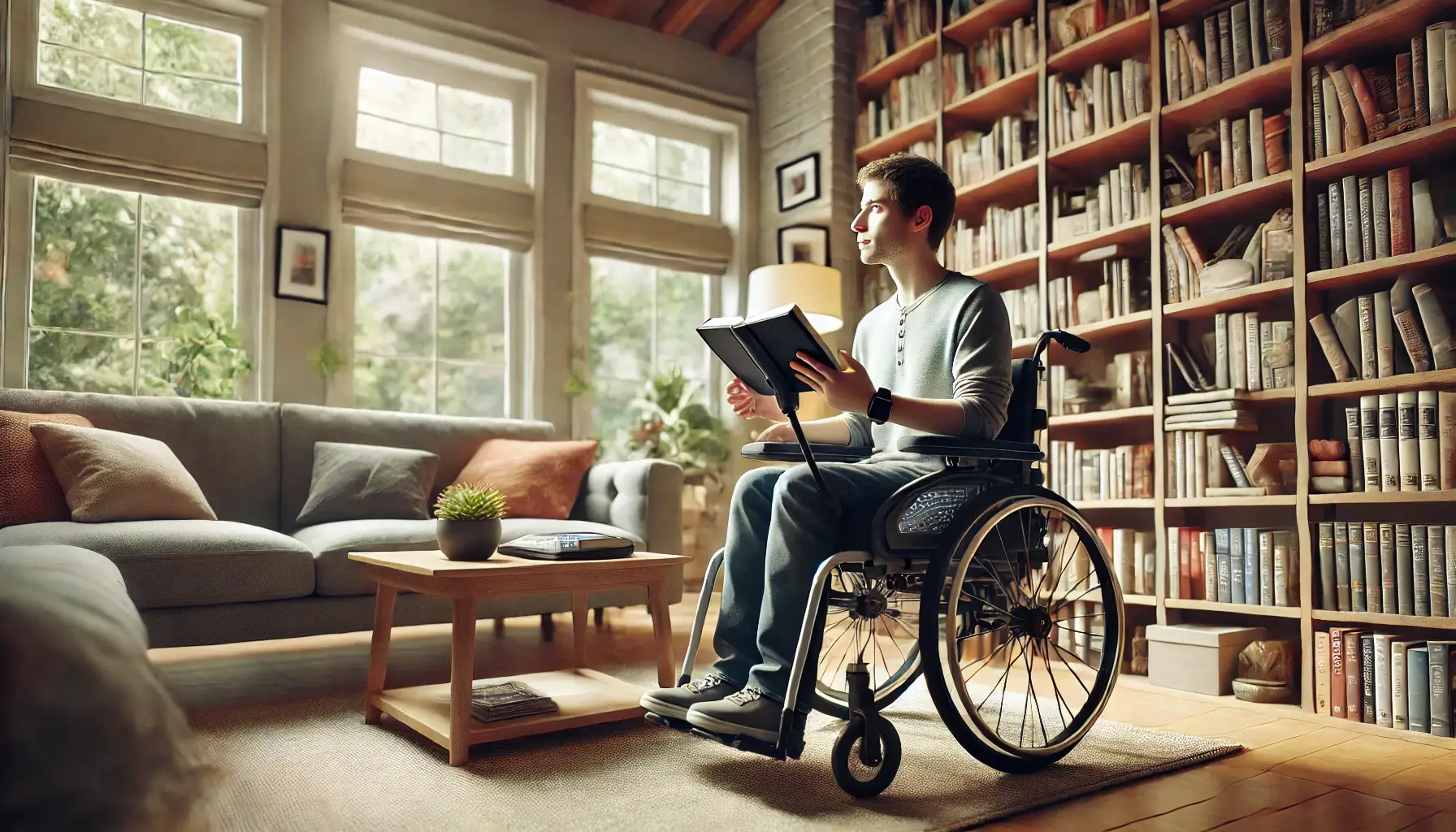Achieving Independent Living: IEP Goals and Daily Living Skills

Introduction

Setting goals for independent living is crucial for fostering self-reliance and autonomy in individuals with disabilities. These goals help students develop the necessary skills to manage daily life effectively, enhancing their overall quality of life and independence.
An Individualized Education Program (IEP) is a vital tool in promoting independent living for students with disabilities. It provides a structured plan tailored to each student's unique needs, outlining specific goals and the steps needed to achieve them. The IEP includes objectives that focus on developing skills such as personal care, home management, and social interaction, all essential for independent living.
This article aims to guide you through the process of setting and achieving independent living goals. It will cover the basics of IEP goals, the importance of daily living skills, and strategies for creating effective and personalized goals. By understanding and implementing these concepts, you can help ensure that individuals with disabilities are better prepared for independent living.
What are Daily Living Skills IEP Goals And Objectives?
Understanding the Basics of an IEP Goal
Individualized Education Program (IEP) goals are specific targets set to address the unique needs of students with disabilities. These goals are designed to help students develop essential skills for daily living, ensuring they can function independently as much as possible. IEP goals are crucial in guiding educational and developmental strategies tailored to each student's abilities and requirements.
Effective IEP goals must be clear, measurable, and achievable. They should include a specific objective, the steps required to reach that objective, and a timeline for achieving it. These goals are often broken down into smaller, manageable tasks to ensure steady progress. Additionally, regular assessment and adjustment of these goals are essential to accommodate the student's evolving needs and capabilities.
How Daily Living Skills Contribute to Independent Living
Daily living skills are fundamental for independent functioning. These skills include basic activities such as personal hygiene, meal preparation, and managing personal finances. By mastering these skills, individuals can handle everyday tasks more efficiently, leading to greater independence and self-confidence.
Developing daily living skills offers several benefits. It enhances an individual's ability to perform everyday tasks independently, reduces reliance on others, and improves overall quality of life. Furthermore, these skills are essential for successful integration into the community and achieving long-term personal goals. To learn about the necessary resources to accomplish these goals, check out Goalsetting.online
Examples of Daily Living Skills in IEPs
Personal Hygiene and Self-Care: Personal hygiene and self-care are crucial components of daily living skills. Goals in this area may include tasks like brushing teeth, bathing, grooming, and dressing appropriately.
Home Management and Safety: Home management skills involve maintaining a clean and safe living environment. This includes tasks such as cleaning, organizing, and understanding basic safety procedures like using kitchen appliances safely.
Financial Literacy and Budgeting: Financial literacy and budgeting are essential for managing personal finances. Goals might include understanding how to budget, save money, and make informed purchasing decisions.
By focusing on these areas, IEP goals can significantly enhance a student's ability to live independently and manage daily life effectively. For more information on how to set and plan goals, visit Goalsetting.online
How to Set Effective Independent Living Goals
Setting effective IEP goals starts with assessing each student's unique needs and abilities. This assessment helps identify the specific skills the student needs to develop to achieve greater independence. A thorough evaluation includes input from educators, parents, and the students themselves.
Individualizing Life Skills IEP Goals
Once the needs and abilities are assessed, goals should be customized to fit each student. Personalized goals ensure that the tasks are achievable and relevant to the student's daily life. Tailoring the goals to individual needs makes them more meaningful and attainable, leading to better outcomes. For instance, a personalized goal might be: "The student will learn to prepare a simple meal independently by the end of the school year, including planning, cooking, and cleaning up."
Setting Measurable and Achievable Goals
Using the SMART framework is essential in setting effective IEP goals. SMART stands for Specific, Measurable, Achievable, Relevant, and Time-bound. This framework ensures that each goal is clear and reachable within a specified timeframe.
Ensuring Goals Are Specific, Measurable, Achievable, Relevant, and Time-Bound
- Specific: Goals should be well-defined and clear.
- Measurable: There should be criteria to measure progress.
- Achievable: Goals should be realistic and attainable.
- Relevant: Goals should be important to the student's needs.
- Time-bound: Each goal should have a deadline.
For an in-depth guide on writing SMART IEP goals, visit Understood.org
Incorporating Activities of Daily Living
Incorporating activities of daily living (ADLs) into IEP goals is vital for fostering independence. ADLs include tasks such as dressing, feeding, and personal hygiene. These activities are fundamental for students to manage their daily lives effectively.
Strategies for integrating ADLs into IEP goals involve breaking down each activity into smaller, manageable steps. This approach makes it easier for students to learn and master each task. Regular practice and reinforcement help solidify these skills.
Examples of daily living activities that can be included in IEP goals are:
- Dressing: "The student will dress independently, selecting appropriate clothing for the weather, by the end of the term."
- Feeding: "The student will prepare their breakfast independently, including setting the table and cleaning up afterward, three times a week."
By setting personalized, measurable, and achievable goals, and incorporating essential daily living activities, students can develop the skills necessary for independent living. For more details on setting and planning SMART objectives, visit Goalsetting.online
Key Areas of Need for Students with Disabilities

Personal Care and Hygiene
Personal care and hygiene are essential skills for students with disabilities. Teaching self-care routines involves step-by-step instructions and consistent practice. These routines include tasks such as brushing teeth, bathing, grooming, and dressing appropriately. Clear and repetitive teaching methods help students learn and remember these important daily tasks.
Developing good hygiene habits is crucial for health and social acceptance. Students should be encouraged to practice these habits regularly. Setting specific goals, such as brushing teeth twice a day or bathing every evening, can help establish these routines. For guidelines on healthy hygiene practices, refer to Tascc.ca
Social Skills and Self-Advocacy
Social skills are vital for students with disabilities to interact effectively with others. These skills include making eye contact, listening, responding appropriately, and understanding social cues. Developing strong social skills can improve relationships and help students integrate into various social settings.
Self-advocacy involves teaching students how to understand their needs and communicate them effectively. This includes asking for help, expressing preferences, and understanding their rights. Self-advocacy empowers students to take control of their lives and make informed decisions. For more on setting and achieving goals, visit Goalsetting.online
Meal Preparation and Nutrition
Learning basic cooking skills is crucial for independent living. These skills include understanding kitchen safety, following simple recipes, and preparing basic meals. Cooking at home promotes healthy eating and self-sufficiency.
Nutrition is vital for maintaining health and well-being. Students should learn about balanced diets, portion control, and the importance of various nutrients. Educating students on how to make healthy food choices helps them maintain a healthy lifestyle. For more information on healthy eating guidelines, check out Unilever.co.za
How to Incorporate Transition IEP Goals
Understanding Transition Services
Transition services are designed to help students with disabilities move from school to post-school activities. These services include educational programs, vocational training, and other support necessary for the student's transition to adulthood. Transition services are essential for preparing students for life after school, ensuring they have the skills and support needed for a successful future. Transition services encompass a variety of supports, such as:
- Career counseling
- Job training
- Life skills education
- Assistance with college applications
- Work placements
- Independent living skills
The goal is to provide a comprehensive support system that addresses all areas of a student's life as they move into adulthood. For more information on goal setting coaching, visit Goalsetting.online
Vocational Skills and Job Readiness
Vocational skills are crucial for students with disabilities to succeed in the workforce. These skills include job-specific abilities, such as technical skills, as well as general work habits, like punctuality and teamwork. Preparing students for employment involves providing opportunities for work experience and training in real-world settings. Job-related skills include:
- Resume writing
- Interviewing techniques
- Understanding workplace expectations
Teaching these skills helps students become more confident and competent in job-seeking and job-keeping activities. Practical exercises, such as mock interviews and job shadowing, are effective methods for teaching these skills. An example of a vocational IEP goal might be: "The student will complete a 10-week internship program, demonstrating punctuality and task completion with minimal supervision."
Public Transportation and Community Access
Accessing the community is vital for students with disabilities to live independently. It allows them to attend work, school, and social events, thereby enhancing their quality of life and sense of belonging. It is a key aspect of independent living. Students should learn to:
- Read schedules
- Plan routes
- Handle unexpected changes in their commute
Teaching these skills can involve practical lessons, such as taking supervised trips on local transit.
Community participation involves more than just getting around; it includes:
- Engaging in local events
- Accessing community services
- Socializing with peers
Teaching students how to find and participate in community activities helps them feel more connected and independent.
Strategies for Living Skills Development

Task Analysis and Step-by-Step Instruction
Task analysis involves breaking down complex tasks into smaller, manageable steps. This method makes it easier for students to learn and perform each part of the task successfully. For example, teaching a student to make a sandwich can be broken down into steps like gathering ingredients, spreading condiments, and assembling the sandwich. Providing detailed instructions helps students understand each step clearly and reduces confusion. Clear and concise directions are essential for effective learning and execution. Each step should be described in simple terms, and visual aids can be used to enhance understanding. Examples of task analysis might include:
- Personal Hygiene: Breaking down the steps for brushing teeth into "pick up toothbrush," "apply toothpaste," "brush each section of teeth," and "rinse mouth."
- Cooking: Steps for making pasta could include "boil water," "add pasta," "stir occasionally," "drain water," and "add sauce."
Using Prompts Effectively
Prompts are cues used to help students complete tasks. They can be verbal, visual, or physical. Verbal prompts involve giving spoken instructions, visual prompts use images or symbols, and physical prompts involve guiding the student's movements.
Fading prompts involves gradually reducing the level of assistance provided. This helps students become more independent over time. For example, starting with physical guidance and moving to verbal prompts, then to no prompts at all as the student masters the task. For resources on necessary tools and strategies to accomplish goals, refer to Goalsetting.online
Collaborating with the IEP Team
Effective collaboration among IEP team members is crucial for developing and implementing successful IEP goals. This team typically includes educators, parents, specialists, and the student. Working together ensures that all perspectives are considered and that the student's needs are fully addressed. Strategies for effective communication and collaboration include:
- Regular Meetings: Schedule frequent meetings to discuss progress and make adjustments.
- Clear Communication: Ensure all team members clearly understand the goals and strategies.
- Documentation: Keep detailed records of meetings and decisions to track progress and accountability.
Consistency is key to achieving IEP goals. All team members should implement strategies consistently across different settings and activities. This uniformity helps reinforce learning and skill development.
Real-Life Examples: IEP Goal Ideas for Independent Living
Functional Life Skills
Functional life skills are essential for daily independence. These skills include managing personal care, household chores, and basic financial tasks. Examples of functional life skills goals might be:
- "The student will independently complete a daily hygiene routine, including brushing teeth, washing face, and combing hair, five days a week."
- "The student will sort laundry by color and fabric type and operate the washing machine independently, twice a week."
Practical skills are crucial for managing everyday tasks without assistance. Developing these skills enhances self-reliance and confidence, enabling students to handle various aspects of daily life effectively.
Postsecondary Goals and Objectives
Postsecondary goals focus on preparing students for life after high school, including higher education, employment, and independent living. These goals should be specific, measurable, and tailored to the student's interests and abilities. Postsecondary goals might include continuing education, job training, or living independently. These goals help students transition smoothly from school to adulthood, ensuring they have a clear path to follow. Examples include:
- "The student will apply to three colleges or vocational programs by the end of the semester."
- "The student will secure part-time employment in an area of interest within six months of graduation."
Self-Advocacy and Independent Functioning
Self-advocacy is about understanding one's rights and communicating needs effectively. Teaching these skills empowers students to make informed decisions and seek the support they need. Goals might include:
- "The student will identify and communicate their learning preferences and needs in an IEP meeting by the end of the school year."
- "The student will practice requesting accommodations in various settings, such as school and community activities, three times per month."
Independence across different settings, such as home, school, and community, is vital for overall development. Achieving independence in these areas ensures that students can navigate their environments confidently and competently.
By setting realistic and practical IEP goals, students can develop the skills necessary for independent living, ensuring they are well-prepared for life beyond school.
Conclusion
Transition goals play a crucial role in the IEP process, especially when it comes to independent living. These goals include developing self-advocacy skills and problem-solving skills to support students with special needs. Writing annual goals and setting specific transition services help meet the overall goal of fostering independent functioning. The IEP transition goals are tailored to the needs of the student, ensuring they receive the support they need to succeed.
Transition planning is essential for older students, and it involves a range of areas, from daily activities to community-based instruction. Sample goals might include learning to use cooking utensils, improving math skills, and engaging in daily interactions. Transition assessments and choosing the right goals to help each student are vital components of this planning.
Daily living skills, such as using tools and appliances, are integral to a student's IEP. Goals to meet these skills might focus on practical tasks and life skills ideas, ensuring students are prepared for daily activities. Specific transition services, such as related service support, are crucial for effective transition planning.
By focusing on goal-setting and goal writing, educators can ensure students are equipped with the necessary skills for independent living. Check back often for updates and new strategies to enhance the individualized education plan and support students in their transition journey.
FAQs
What are the key components of an IEP goal for independent living?
Key components of an IEP goal for independent living include clear objectives, measurable criteria, and specific timelines. These elements ensure that the goals are attainable and progress can be tracked effectively. Each goal should be tailored to the individual student's needs and abilities to maximize their potential for independence.
How do daily living skills contribute to a student's independence?
Daily living skills are essential for managing personal and household tasks, promoting self-sufficiency. These skills include personal hygiene, meal preparation, and financial management. Mastering these tasks allows students to handle their day-to-day activities independently, reducing reliance on others and increasing their confidence and quality of life.
What are some examples of daily living skills included in IEPs?
Examples of daily living skills in IEPs include:
- Personal Hygiene: Brushing teeth, bathing, and grooming.
- Meal Preparation: Planning and cooking meals, understanding nutrition.
- Financial Management: Budgeting, saving money, and making informed purchasing decisions.
How can I ensure my child's IEP goals are effective?
To ensure your child's IEP goals are effective, use the SMART criteria:
- Specific: Clearly define the goal.
- Measurable: Include criteria to track progress.
- Achievable: Ensure the goal is realistic.
- Relevant: Align the goal with the student's needs.
- Time-bound: Set a deadline for achieving the goal.
For more on setting SMART objectives, visit Goalsetting.online
What role do transition services play in IEPs?
Transition services help students prepare for life after school, including employment and community participation. These services provide support and training in areas such as vocational skills, job readiness, and independent living. Transition services are essential for ensuring a smooth and successful transition from school to adulthood. For more information on transition services and coaching, refer to Goalsetting.online